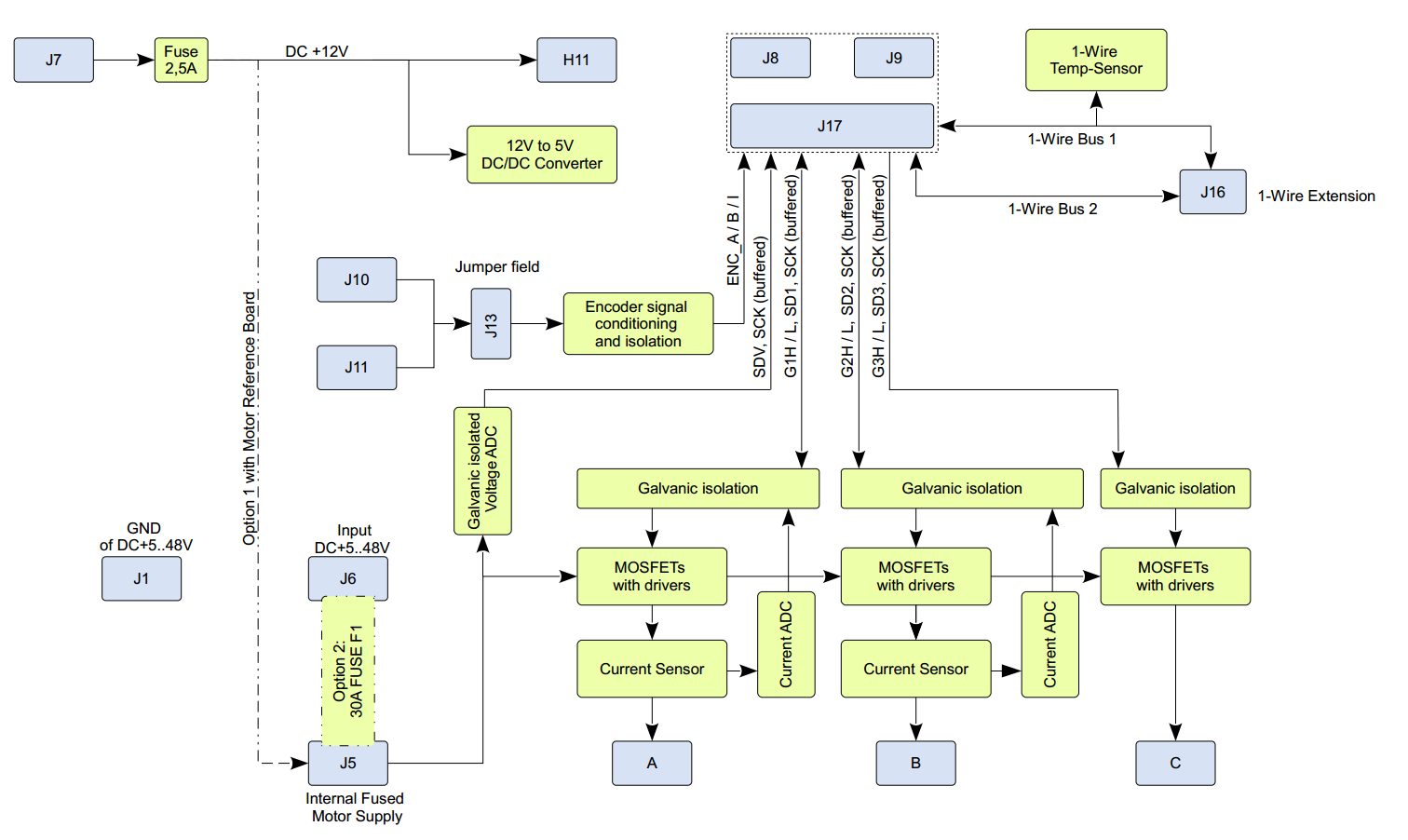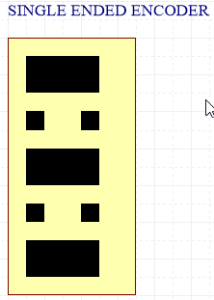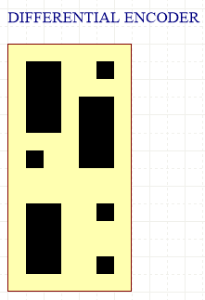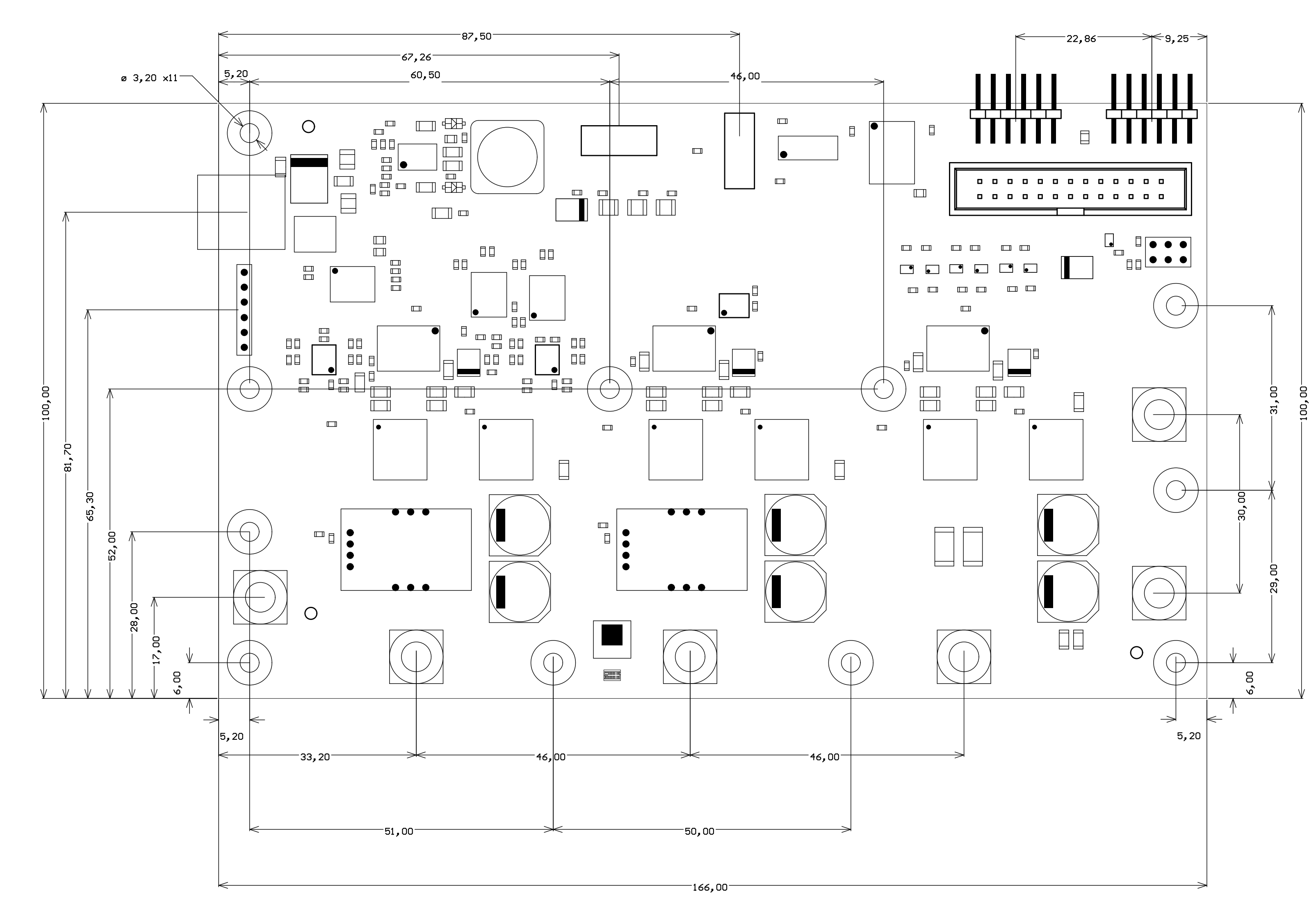Key Features
- Motor control evaluation with an suitable controller board
- Quick evaluation with reference motor board
- Power option up to 48V and 30A main supply current
Block Diagram
Main Components
- MOSFET Power Stage supporting 3-phase BLDC Motors
- Current measurement on 2-phases (3 phase measurement optional)
- Temperature sensor on board and 1-Wire bus connector for additional sensors
- Encoder input capable of receiving both single ended and differential signals
General Safety Instructions
- This product is only allowed to be used by an electrical specialist.
- This product is not allowed to be used unattended.
- There is a possible risk of burns due to hot surfaces while running the Board. This e.g. might be caused by an overcurrent at the motor outputs.
- All externally connected power sources must be SELV protected (Separated or safety extra-low voltage).
- For set up the wiring switch off or disconnect all external power supplies.
- During operations it is not allowed to change the wiring or mechanical setup.
- This product is only allowed to be used in a dry indoor environment.
- The product is only allowed to be used in horizontal position on a non-conducting and non-inflammable surface.
- The mechanical setup must ensure that the whole test setup can not be dropped to the floor or moved accidentally.
Signals, Interfaces and Pins
Control Board Connections
| Signal names | Connector J8 | Connector J9 | Connector J17 |
|---|---|---|---|
Digital Supply to EDPS | Pin 6, 12: +3.3V | Pin 6, 12: +3.3V Pin 5, 11: GND | Pin 5, 6, 21, 22: +3.3V Pin 1, 2, 25, 26: GND |
Motor Driver PWM Signals to EDPS High and Low Side control signals
| Pin 1: G1H - Ch.A HighSide | Pin 11: G1H - Ch.A HighSide | |
| ADC Clock Signal to EDPS | Pin 1: SCLK | Pin 23: SCLK | |
| Encoder Digital Signals from EDPS | Pin 8: ENC_A | Pin 20: ENC_A | |
| Motor Current ADC "raw" Signals from EDPS (usable with FPGA IP) | Pin 2: SDI1 - Current Ch.A | Pin 19: SDI1 - Current Ch.A | |
| Supply Voltage ADC "raw" Signal from EDPS (usable with FPGA IP) | Pin 7: SDIV - from DC_LINK | Pin 24: SDIV - from DC_LINK | |
| 1-Wire bus for temperature measurement | Pin 10: EXT1 - 1-Wire Bus 1 Pin 4: EXT2 - 1-Wire Bus 2 | Pin 4: EXT1 - 1-Wire Bus 1 | |
| Not connected pins | none | none | Pin 13, 14 |
Motor and Power Connections
There are two options available for the motor and power concept:
| Detail | Option 1: Reference Motor Board with DC +12V Supply | Option 2: Customer Motor at individual DC +5..48V | Comments |
|---|---|---|---|
| Motor Supply | From DC +12V Input J7 via Fuse F3 (TODO ... A) | From customer DC Supply to J6 via F1 on Drive Boad | |
| Motor Connection | Motor wires connected to cage clamps on Motor Reference Board J5 (A), J4 (B), J3 (C) | Motor wires connected to bolt screw terminals on Drive Board J2 (A), J3 (B), J4 (C) | |
Encoder Connection Single Ended | From encoder pins via 6Pin PMoD to Drive Board J10: J10 single ended:Pin 1: GND | From motor to Drive Board to J11 (single/differential): J11 single ended:Pin 2: +5V Supply | Jumper Settings for encoder signals.
|
Encoder Connection Differential | J11 differential with 100R terminated: Pin 2: +5V Supply Pin 3: GND Pin 5: ENC A negativ Pin 6: ENC A positiv Pin 7: ENC B negativ Pin 8: ENC B positiv Pin 9: ENC I negativ Pin 10: ENC I positiv |
Internal
Temperature Sensor
Onboard is a Maxim 1-Wire Temperature sensor DS18S20Z+. This sensor is located in the middle of the PCB.
Addional 1-Wire sensor(s) can be connected to the connector J16:
- Pin 1(DQ), 3 (GND),5 (+3.3V) at the same 1-wire bus as the onboard one
- Pin 2(DQ), 4 (GND),6 (+3.3V) at a separate 1-wire bus
Power and Power-On Sequence
DC 12V Supply Motor and Driver
The power source must be SELV (Separated or safety extra-low voltage) protected.
The motor drivers and the reference motor on the pre-mounted motor board TEC0060 are supplied by this voltage.
The internal +5V digital supply is generated from this +12V supply.
DC 5...48V Supply for Motor only
SAFETY INSTRUCTIONS:
Externally power supply for the motor must be SELV (Separated or safety extra-low voltage) protected.
This option is
- only allowed to be used for electrical specialist for the used electrical voltage and power conditions
- only allowed to be used under electrical laboratory conditions
- only allowed to be used in horizontal position on a non-conducting and non-inflammable surface
- only allowed to be used with a wiring, which fulfills the current rating for the maximum possible currents.
- only allowed to be used with a suitable current limiting circuit
- The maximum continuous current must not exceed 30A.
- The delivered fuse "Littelfuse Tpye 142.5631.5302" must be used as current limiter between connector J5 and J6.
- To limit the current for smaller motor loads an ADDITIONALLY appropriate current limiter can be used e.g. a current limited power source or a fuse integrated in the wiring.
- only allowed to be used with appropriate connectors at the M5 screw connectors, which means M5 cable lugs must be used and fastened according to technical standards.
- only allowed to be used, if the "Drive Boad high current signals" conducting up to 30A nominal, are covered by isolating, mechanically stable, non-inflammable (UL V-1 or better) material
The "Drive Board high current signals" are the motor outputs A, B, C and Fuse F1 Connectors J5 an J6 and further internal connections shown white marked in the following picture:
- As minimum protection it is mandatory to use the delivered "Isolating cover PCB" (marked in green), which must be mounted to the mounting holes H1, H9, H3, H4 with the delivered 10mm isolating spacers:
- The used cable lugs need to be isolated in the area outstanding the outer border of the Drive Board.
Make sure that the "Isolating Cover PCB" is overlapping the conducting material by a minimum of 20 mm.
Initial operation
To use a separate power supply for the motor supply perform the following steps:
- Disconnect the reference motor board TEC0060 by unmounting its screws and the encoder cable from J10
- Mount the delivered 30A fuse to the connectors J5 and J6 with the delivered M5 screws
- For lower supply current requirements, caused by the power rating of the used motor, a fuse with a lower and suitable current rating integrated in the supply wiring is recommended.
- Connect with cable lugs the +DC 5..48V to J6 and the corresponding GND to J1.
- The cable length is limited to 3m.
- Connect the three motor phases to J2 (A), J3 (B) and J4 (C).
- The cable length is limited to 3m.
- Optional: connect the encoder to J10 or J11 and set jumper field according to signal specification: differential or single ended. See section TODO for details.
Power-On Sequence
Any power sequence of the three supply sources is allowed:
- +3V3 Supply from the Control Board, generated by Control Board supply
- +12V and
- optional +5..48V Motor Supply
Reference Motor Board TEC0060
For easy connection of the reference Motor and Encoder to the Driver board a special Motor Adapter Board TEC0060 is included in the EDDP Kit.
Reference Motor
The reference motor is manufactured by Anaheim Automation. The order code for the motor with the encoder already mounted is BLWR111D-24V-10000-1000SI. Please note that the encoder is not available separately. The nominal motor voltage is DC 24V, however, only 12V is supplied by the Reference Motor Board, which results in reduced performance.
The datasheet for the motor can be found at
http://www.anaheimautomation.com/manuals/brushless/L010234%20-%20BLWR11%20Series%20Product%20Sheet.pdf
The datasheet for the encoder can be found at
http://www.anaheimautomation.com/manuals/accessories/L010390%20-%20Single%20Ended%20Encoder%20with%20Index%20Channel.pdf
Technical Specifications
Absolute Maximum Ratings
| Parameter | Min | Max | Units | Notes |
|---|---|---|---|---|
DC +12V supply | 0 | 15 | V | |
| DC +5..48V supply | 0 | 50V | V | |
| DC +3V3 supply | -0.5 | 6 | V | |
| PWM Input | -0.5 | 6 | V | |
| ADC Digital Input | -0.5 | 3.8 | V | DC +3V3 = 3.3V |
| Encoder Input | -10 | 15 | V |
Recommended Operating Conditions
| Parameter | Min | Max | Units | Notes |
|---|---|---|---|---|
DC +12V supply | 11.5 | 12.5 | V | |
| DC +5..48V supply | 5 | 48 | V | |
| DC +3V3 supply | 3.0 | 3.6 | V | |
| PWM Input | 0 | DC +3V3 supply | V | |
| ADC Digital Input | 0 | DC +3V3 supply | V | |
| Encoder Input | -7 | 12 | V |
Electrical characteristics
DC +3V3 supply = 3.3V
| Parameter | Min | Max | Units | Notes |
|---|---|---|---|---|
| PWM Input Logic High Level | 2.2 | V | ||
| PWM Input Logic Low Level | 0.8 | V | ||
| ADC Digital Input Logic High Level | 2.7 | V | ||
| ADC Digital Input Logic Low Level | 0.6 | V | ||
| ADC Digital Output Logic High Level | 3.2 | 3.3 | V | Io=-200μA |
| ADC Digital Output Logic Low Level | 0 | 0.4 | V | Io=+200μA |
| Encoder Input Logic High Level (Differential) | -0.2 | V | ||
| Encoder Input Logic Low Level (Differential) | -0.01 | V | ||
| Encoder Input Logic High Level (Single Ended) | 2 | V | ||
| Encoder Input Logic Low Level (Single Ended) | 0.6 | V |
Physical Dimensions
Board size: 100 mm × 166 mm. Please download the assembly diagram for exact numbers.
PCB thickness: 1.75 mm +/-10%
Highest part on PCB: approximately 17 mm. Please download the step model for exact numbers.
All dimensions are shown in mm. Additional sketches, drawings and schematics can be found TODO: here.
Operating Temperature Ranges
0°C - 70°C, cooling might be required, depending on environment and airflow.
References
All resource links for other relevant documents and websites are available from Trenz EDDP Web Hub:
Revision History
Hardware Revision History
| Date | Revision | Notes | PCN Link | Documentation Link |
|---|---|---|---|---|
| 2016-03-27 | 02 | TEC0053-02 | ||
| 2017-08-14 | 04 |
Hardware revision number is printed on the PCB board in the bottom right corner.
Document Change History
Date | Revision | Authors | Description |
|---|---|---|---|
| 2017-03-30 |
| Andreas Heidemann | Initial Version |
The material contained in this document is provided “as is” and is subject to being changed at any time without notice. Trenz Electronic does not warrant the accuracy and completeness of the materials in this document. Further, to the maximum extent permitted by applicable law, Trenz Electronic disclaims all warranties, either express or implied, with regard to this document and any information contained herein, including but not limited to the implied warranties of merchantability, fitness for a particular purpose or non infringement of intellectual property. Trenz Electronic shall not be liable for errors or for incidental or consequential damages in connection with the furnishing, use, or performance of this document or of any information contained herein. In no event will Trenz Electronic, its suppliers, or other third parties mentioned in this document be liable for any damages whatsoever (including, without limitation, those resulting from lost profits, lost data or business interruption) arising out of the use, inability to use, or the results of use of this document, any documents linked to this document, or the materials or information contained at any or all such documents. If your use of the materials or information from this document results in the need for servicing, repair or correction of equipment or data, you assume all costs thereof. No part of this manual may be reproduced in any form or by any means (including electronic storage and retrieval or translation into a foreign language) without prior agreement and written consent from Trenz Electronic. The hardware / firmware / software described in this document are furnished under a license and may be used /modified / copied only in accordance with the terms of such license. To confront directly with the responsibility toward the environment, the global community and eventually also oneself. Such a resolution should be integral part not only of everybody's life. Also enterprises shall be conscious of their social responsibility and contribute to the preservation of our common living space. That is why Trenz Electronic invests in the protection of our Environment. REACH Trenz Electronic is a manufacturer and a distributor of electronic products. It is therefore a so called downstream user in the sense of REACH. The products we supply to you are solely non-chemical products (goods). Moreover and under normal and reasonably foreseeable circumstances of application, the goods supplied to you shall not release any substance. For that, Trenz Electronic is obliged to neither register nor to provide safety data sheet. According to present knowledge and to best of our knowledge, no SVHC (Substances of Very High Concern) on the Candidate List are contained in our products. Furthermore, we will immediately and unsolicited inform our customers in compliance with REACH - Article 33 if any substance present in our goods (above a concentration of 0,1 % weight by weight) will be classified as SVHC by the European Chemicals Agency (ECHA). RoHS Trenz Electronic GmbH herewith declares that all its products are developed, manufactured and distributed RoHS compliant. WEEE Information for users within the European Union in accordance with Directive 2002/96/EC of the European Parliament and of the Council of 27 January 2003 on waste electrical and electronic equipment (WEEE). Users of electrical and electronic equipment in private households are required not to dispose of waste electrical and electronic equipment as unsorted municipal waste and to collect such waste electrical and electronic equipment separately. By the 13 August 2005, Member States shall have ensured that systems are set up allowing final holders and distributors to return waste electrical and electronic equipment at least free of charge. Member States shall ensure the availability and accessibility of the necessary collection facilities. Separate collection is the precondition to ensure specific treatment and recycling of waste electrical and electronic equipment and is necessary to achieve the chosen level of protection of human health and the environment in the European Union. Consumers have to actively contribute to the success of such collection and the return of waste electrical and electronic equipment. Presence of hazardous substances in electrical and electronic equipment results in potential effects on the environment and human health. The symbol consisting of the crossed-out wheeled bin indicates separate collection for waste electrical and electronic equipment. Trenz Electronic is registered under WEEE-Reg.-Nr. DE97922676. Disclaimer
Document Warranty
Limitation of Liability
Copyright Notice
Technology Licenses
Environmental Protection
REACH, RoHS and WEEE












